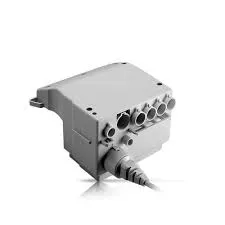Understanding Medium Voltage Fusion Tape An Essential Tool for Electrical Insulation
In the realm of electrical engineering, reliable insulation is paramount for the safety and efficiency of power systems. One innovative solution steadily gaining traction is medium voltage fusion tape. This type of tape is designed to enhance the performance and longevity of electrical connections, especially in medium voltage applications. Understanding its properties, applications, and benefits can help professionals make informed decisions about its use in various electrical installations.
What is Medium Voltage Fusion Tape?
Medium voltage fusion tape is a specially engineered adhesive tape used primarily for insulating, protecting, and sealing electrical connections and splice points in medium voltage systems, which typically operate in the range of 1kV to 35kV. Made from high-quality polymeric materials, this tape features excellent dielectric strength, temperature stability, and resistance to environmental factors such as moisture, UV radiation, and chemicals.
The unique aspect of fusion tape lies in its ability to bond with itself when heat is applied. This self-fusing characteristic means that it can create a seamless, waterproof barrier, thereby minimizing the risk of electrical failure due to moisture ingress or other external influences. This is particularly crucial in outdoor installations or harsh environments where traditional insulation methods may fall short.
Applications of Medium Voltage Fusion Tape
The applications for medium voltage fusion tape are vast and varied. It is predominantly used in the following areas
1. Cable Jointing and Repair Fusion tape is an excellent choice for repairing damaged cables or joints. Its self-fusing feature ensures that it can tightly adhere to the surrounding insulation, providing a robust solution that restores integrity and functionality.
2. Insulation of Live Parts In medium voltage installations, certain components may need to be insulated while still in service. Fusion tape allows for live insulation, providing a safe means of protecting operators while performing maintenance on equipment.
3. Environmental Protection The tape is effective in sealing electrical connections from moisture, dirt, and extreme temperatures. This protection prolongs the life of electrical components and maintains the integrity of connections over time.
medium voltage fusion tape

4. Bundling and Clamping Fusion tape can serve as a bundling solution for multiple cables, providing a neat and organized layout while also adding an extra layer of protection against abrasion and environmental damage.
Benefits of Using Medium Voltage Fusion Tape
Investing in medium voltage fusion tape brings several benefits to electrical installations
1. Enhanced Safety The tape's insulating properties dramatically reduce the risk of electrical shorts and failures, contributing to overall system safety.
2. Ease of Application Medium voltage fusion tape is user-friendly and can be applied quickly, even in challenging conditions. The heat-activated fusing process simplifies the installation and ensures a tight fit without the need for additional adhesives.
3. Cost-Effectiveness By effectively extending the lifespan of electrical components and reducing maintenance needs, fusion tape can lead to significant cost savings over time.
4. Versatility This tape is compatible with a wide variety of materials and surfaces, making it suitable for diverse applications across different industries, including utilities, telecommunications, and manufacturing.
5. Environmental Resistance With a strong resistance to environmental factors, medium voltage fusion tape minimizes the need for frequent replacements or repairs, proving to be a sustainable choice for long-term use.
Conclusion
In conclusion, medium voltage fusion tape represents a modern solution for the challenges posed by electrical insulation in medium voltage applications. Its unique self-fusing properties, combined with its versatility and effectiveness in protecting electrical connections, make it an indispensable tool for engineers and technicians alike. As technology continues to evolve, the use of such innovative materials will undoubtedly play a crucial role in ensuring the safety and reliability of electrical systems across various sectors. Embracing these advancements can lead to smarter, safer, and more efficient electrical installations.
-
XIANGFAN Rubber Tape-Ultimate Solutions for All Your Insulation NeedsNewsJun.24,2025
-
XIANGFAN Rubber Tape-Protection for Industrial and Residential ApplicationsNewsJun.24,2025
-
XIANGFAN Rubber Tape: Superior Safety and Sealing for Demanding EnvironmentsNewsJun.24,2025
-
XIANGFAN Rubber Tape: Reliable Solutions for Every Electrical ChallengeNewsJun.24,2025
-
XIANGFAN Electrical & Industrial Tape: Powering Reliability Across IndustriesNewsJun.24,2025
-
XIANGFAN Electrical & Industrial Tape: Excellence in Every ApplicationNewsJun.24,2025
